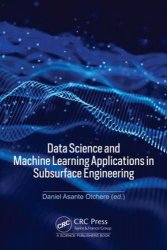Data Science and Machine Learning Applications in Subsurface Engineering
- Добавил: literator
- Дата: 14-11-2023, 19:25
- Комментариев: 0
 Название: Data Science and Machine Learning Applications in Subsurface Engineering
Название: Data Science and Machine Learning Applications in Subsurface EngineeringАвтор: Daniel Asante Otchere
Издательство: CRC Press
Год: 2024
Страниц: 322
Язык: английский
Формат: pdf (true)
Размер: 27.5 MB
The utilization of Machine Learning (ML) techniques to understand hidden patterns and build data-driven predictive models from complex multivariate datasets is rapidly increasing in many applied science and engineering disciplines, including geo-energy. Motivated by these developments,Machine Learning Applications in Subsurface Energy Resource Management presents a current snapshot of the state of the art and future outlook for ML applications to manage subsurface energy resources (e.g., oil and gas, geologic carbon sequestration, and geothermal energy).
The chapters in this book cover a wide range of application areas, including data-driven workflows for subsurface characterisation at the well scale and the reservoir scale, Machine Learning techniques for well performance analysis, and smart completions. Diverse data types are analyzed including well flow data, wireline log data and seismic images. A variety of Machine Learning algorithms are described, from traditional multivariate statistical methods and tree-based methods to artificial neural networks and deep convolutional neural networks. This book offers valuable insights into the ongoing research and development in the field of subsurface engineering.
It is known that many articles and texts prevent the reader from reproducing the results either because the data were not freely available or because the software was inaccessible, or only available for purchase. Therefore, it was my goal to be as hands-on as possible in stating the methods used, enabling the readers to reproduce the results and extend the methodology to their own data. Furthermore, the authors opted to use the Python language, an open-access software, for all stages of the Machine Learning process.
Most of the chapters contain links to the data sets, Python notebooks, and software used here to reproduce the analyses in each chapter. I selected Python as the computational engine of this book for several reasons. First, Python is freely available for multiple operating systems. I encourage you to take the time to compare each of your solutions with the results in this book. Performing this comparison may help you become more familiar with a technique you could have used to solve a specific problem more efficiently.
Covers ML applications across multiple application domains (reservoir characterization, drilling, production, reservoir modeling, and predictive maintenance)
Offers a variety of perspectives from authors representing operating companies, universities, and research organizations
Provides an array of case studies illustrating the latest applications of several ML techniques
Includes a literature review and future outlook for each application domain
This book is targeted at practicing petroleum engineers or geoscientists interested in developing a broad understanding of ML applications across several subsurface domains. It is also aimed as a supplementary reading for graduate-level courses and will also appeal to professionals and researchers working with hydrogeology and nuclear waste disposal.
Скачать Data Science and Machine Learning Applications in Subsurface Engineering
Внимание
Уважаемый посетитель, Вы зашли на сайт как незарегистрированный пользователь.
Мы рекомендуем Вам зарегистрироваться либо войти на сайт под своим именем.
Уважаемый посетитель, Вы зашли на сайт как незарегистрированный пользователь.
Мы рекомендуем Вам зарегистрироваться либо войти на сайт под своим именем.
Информация
Посетители, находящиеся в группе Гости, не могут оставлять комментарии к данной публикации.
Посетители, находящиеся в группе Гости, не могут оставлять комментарии к данной публикации.
